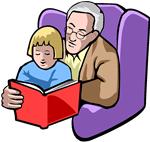Tips for At-Home Read Alouds

Tips for Read-Aloud at Home
Montgomery Township Schools
Research in the field of reading is dramatically clear on one point. Reading aloud to children is the single most important thing a parent can do to ensure reading success. A good read-aloud session includes the reading of a good story and some quality talk about the story. The following suggestions are meant to help parents generate a dialogue with their children about the books they read together.
GENERAL INFORMATION
- Read-aloud to your child at least once a day.
- Set aside regular reading times.
- Share in the choice of books. Allow your child to choose sometimes, while you choose a favorite at other times.
- Read with enthusiasm. Enjoy yourself.
- Occasionally choose books that are “over the head” of your child. Listening comprehension is much more developed in young learners than reading comprehension. More difficult books create an intellectual challenge.
- Don’t read above a child’s emotional level. Really scary books are not good choices for young children.
- Fathers must make an extra effort to do some of the read-alouds.
- Keep reading to your child even after the child has become a fluent reader.
TALKING ABOUT STORIES
Before Reading –
- Look at the title, cover pictures, title page.
- Encourage your child to make predictions. What might the story be about? What might happen in the story?
During Reading –
- Stop occasionally to check predictions. Is this what you thought would happen? Do we need to change our predictions? What new predictions can we make?
- Don’t forget to talk about the pictures. In picture books, illustrations play a central role in telling the story. Talk about the illustrator’s style, the detail, the use of color.
- Discuss meanings and connotations of unfamiliar words.
After Reading –
- Ask questions that invite your child to talk. Avoid yes/no and one word answer questions.
- Ask for feeling responses. How did the story make you feel? What did the story make you think about? What was your favorite part of the story?
- Talk about the characters in the story. Talk about the major events. Compare characters to people you know. Compare events to things that have happened in your life.
- Compare the story to other books you have read or movies or TV shows you have seen together.
Finally, listen to your child and respond to questions in a caring and genuine way. Enjoy read-aloud time. It can be among the most rewarding family experiences.

